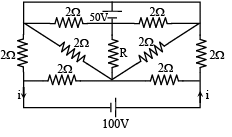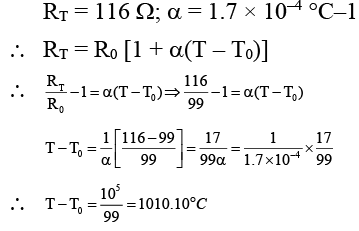Integer Answer Type Questions for JEE: Current Electricity | Chapter-wise Tests for JEE Main & Advanced PDF Download
Q.1. Find the voltmeter in the circuit shown in the figure.
Ans. 0
Current in the circuit I = 3/3 = 1 amp.
potential drop across AB
VAB = 3 x 1 = 3 V
Hence, no potential drop across voltmeter.
Q.2. In the adjoining circuit, the battery E1 has an E.M.F. of 12 volts and zero internal resistance while the battery E2 has an emf of 2 volts. If the galvanometer G reads zero, then the value of the resistance X (in ohms) is
Ans. 100
As there is no current through galvanometer.
Hence VAB = 2V
12 = 500 i + 2 ⇒ i = 1/50 amp
X. 1/50 = 2 ⇒ x = 100Ω
Q.3. Two cells ε1 and ε2 connected in opposition to teach other as shown in figure. The cell ε1 is of emf 9 V and internal resistance 3 Ω the cell ε2 is of emf 7 V and internal resistance 7Ω. Find the potential difference between the points A and B.
Ans. 8.4
Potential difference across cell ε1 is = 9 - 0.2 × 3 = 9 - 0.6 = 8.4 V
Potential difference across ε2; VAB = ε2 + 0.2r2 = 7 + 0.2 × 7
= 7 + 1.4 = 8.4 V
Q.4. A current in a wire is given by the equation, I = 2t2 - 3t + 1, the charge through cross section of wire in time interval t = 3 s to t = 5 s is
Ans. 43.34 C
Q.5. In an atom electrons revolves around the nucleus along a path of radius 0.72 Å making 9.4 × 1018 revolution per second. Find the equivalent current. (e = 1.6 × 10–19 C)
Ans. 1.504 A
Radius of electron orbit r = 0.72 Å = 0.72 x 10-10 m
Frequency of revolution of electron in orbit of given atom u
= 9.4 × 1018 rev/s
(where T is time period of revolution of electron in orbit)
∴ Then equivalent current is I = e/T = ev = 1.6 x 10-19 x 9.4 1 x 1018 = 1.504 A
Q.6. The resistance of a heating element is 99 Ω at room temperature. What is the temperature of the element if the resistance is found to be 116 Ω? (Temperature coefficient of the material of the resistor is 1.7 × 10-4°C-1)
Ans. 1037.1°C
Here, R0 = 99 Ω T0 = 27°C
⇒ T = 1010.1 + T0 = 1010.1 + 27 = 1037.1°C
Q.7. A block of metal is heated directly by dissipating power in the internal resistance of block. Because of temperature rise, the resistance increases exponentially with time and is given by R(t) = 0.5 e2t, where t is in second. The block is connected across a 110 V source and dissipates 7644 J heat energy over a certain period of time. This period of time is ...............× 10–1 sec.
Ans. 5
Let t be the required time. As power is
According to problem,
U = 7644J
or e–2t = 0.367
or –2lne = ln 0.367 or –2t = –1 or t = 0.5 s
Q.8. Consider the circuit shown in figure. What is the current through the battery just after the switch is closed.
Ans. 2
Just after closing of switch S
i1 and i3 (current through inductor is zero)
∴ i = i2
i2 = 18/9
= 2 amp
Q.9. A D.C. supply of 120 V is connected to a large resistance X. A voltmeter of resistance 10 k Ω placed in series in the circuit reads 20 V. This is an unusual use of voltmeter for measuring very high resistance. The value of X is _______ × 10 k Ω (approx).
Ans. 5
or 20 × 10–4x + 20 = 120
= 5 × 104 Ω
= 50 kΩ
Q.10. Each resistance is of 2W. Current in resistance R (R = 2Ω) is ______ + 9.75 ampere.
Ans. 9
At y according to Kirchoff's junction law
5y – 2x = 200 ______(1)
Similarly at x
At x + 100
We get y – 2x = 50 …(4)
From (1) and (4)
y = 37.5 V
So, current through R is 18.75 A.
|
446 docs|929 tests
|



























